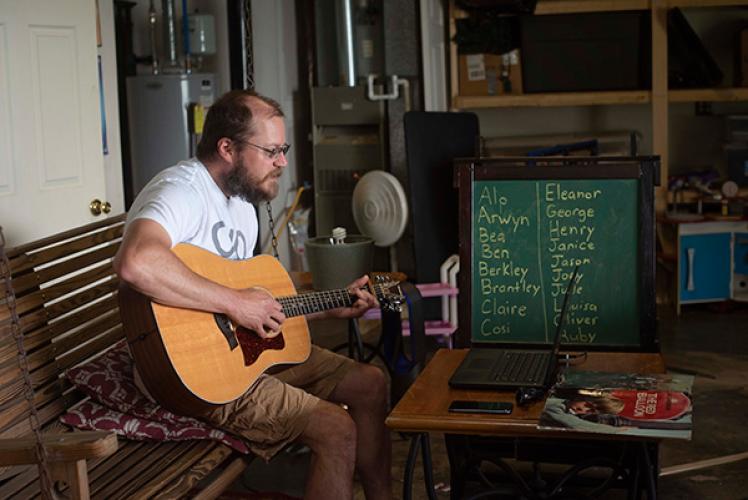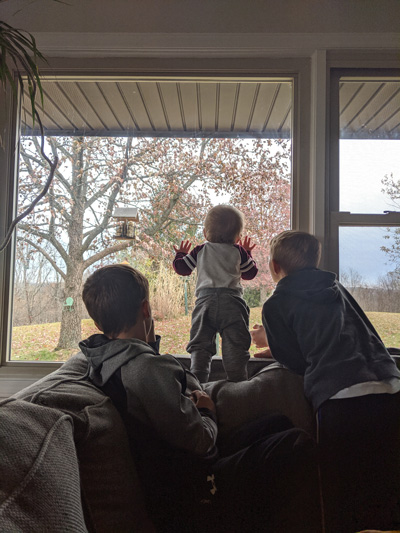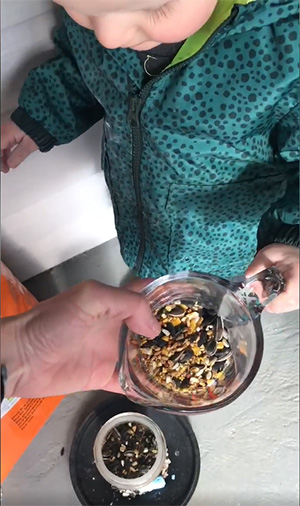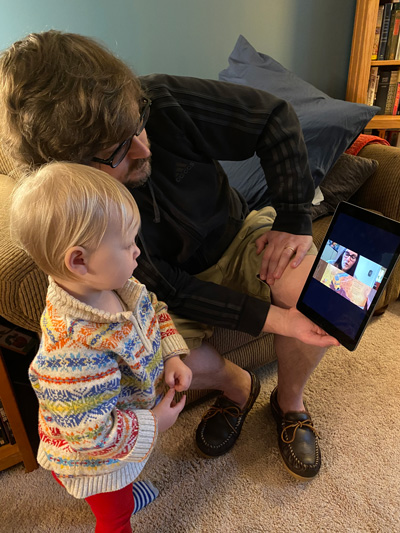
Child Development Center administers creative engagement for young children and families

How do you keep our youngest learners engaged when you are unable to be in a classroom together? Ohio University’s Child Development Center (CDC) has been working to find the answer to that question. The work that continues with children, families, Early Childhood Education Professional Interns and CDC Master Teachers during these challenging times of forced distance learning is nothing short of inspirational.
One-year old children and their families communicate back and forth with teachers, families of toddlers share experiences with each other, and preschoolers stay in communication with peers through video chats and parent posts. But that is not all—they are continuing ongoing interdisciplinary project work through these new formats. Studies of birds, traditional story sharing, creative storytelling, and ongoing work with three-dimensional representation bring the classroom experience into children’s homes.
“In a time where nothing is normal, we tried to bring some normalcy and comfort to students through recycled creations. This activity allowed students to feel connected to their classroom,” said senior Early Childhood Professional Intern Natalie Pennell.
A few short months ago, the infant classroom often observed the black vultures on the Ridges. This interest inspired a new awareness of the variety of birds around the school and playground. To further this interest, the teachers installed a bird feeder right outside the classroom window. The one-year old children would eagerly gather to watch their teacher fill the feeder and patiently await the birds to visit. Visiting the windows to watch the birds and squirrels became a frequent shared experience for the group, sparking excitement and conversation.
With the move to virtual experiences, Master Teacher Lisa Kinnard posted videos of filling the bird feeder at the school and a video of her installing one at her own home. Families responded with photos of children’s reactions. Some families were inspired to install their own bird feeders or use one they had long forgotten.
“It doesn’t matter the location of the learning experience, children are always willing to learn and explore the world around them,” explained Paige Anderson, another senior Early Childhood Professional Intern.
As a provocation for the children, Lisa asked the them what else the birds would like to eat and offered a list of ideas. Several families tried feeding the birds at their own houses and reported back their results.
“I think what is special about this experience and our shared interest is that it allows us all to engage in the same activity at our own homes while communicating with each other through posting pictures about our observations, installing our feeders, or children filling them.” Said Kinnard. “We are able to continue our ongoing work with the children while now incorporating the added benefit of family involvement.”
“Remaining connected to the CDC teachers and friends has been important for both my children,” said Jessica Collura, CDC parent. “My daughter (5) loves to engage in the projects her teachers provide and frequently asks me to share pictures of her work on her class Facebook page. And my son (2) delights in watching videos of his teachers reading books and then recreates the stories with his toys at home.”
In all OHIO CDC classrooms, the Master Teachers use a variety of strategies to stay connected to families during this unprecedented time. Some strategies include Microsoft Teams meetings, setting up private Facebook pages, using GroupMe, ClassTag, email, FaceTime, and handwritten letters. Through these strategies and more the Master Teachers and Professional Interns continue sharing experiences, activities, and provocations for the children. Parents have commented that the children are thrilled to see their teachers and Interns and are posting photos and videos of the children engaging in the activities shared by teachers.
“We’re deeply appreciative of the innovation the Master Teachers and Interns have demonstrated,” said Collura.
Those innovations continue through all the classrooms. A second Infant class shared provocations for children to explore movement through wind since they had been exploring light in the classroom. Toddler classrooms continued projects of storytelling and familiar tales with versions of “The Three Billy Goats Gruff,” “Goldilocks and the Three Bears,” and “The Three Little Pigs.” Preschool classrooms work on observational drawing through Microsoft Teams meetings, story creation, riddles, and more.
In a preschool classroom, a common interest and knowledge base of using recyclable materials for creative and representational work provided a way to continue the classroom community virtually.
Senior Professional Intern Kelsey Majiros said, “We implemented virtual ‘recycled creations’ to encourage community and collaboration. Our classroom was connected through our shared interest of recycled creations.”
Through prompts, videos, virtual meetings and posts to the class social media site, children engaged in creating and sharing the products of their imaginations. As they grew accustomed to the platforms provided for interaction, children and parents began providing details about the thought processes that went into their creations and sharing comments about the works of others. In a few short days, a network of collaborative thought and cooperation had taken hold, and children were proud and excited to engage in conversations during virtual meetings about the creations of the class.
“The outpouring of support and participation from the families in our room was incredible,” said Master Teacher Matt Johnson. “Our interns were able to use this enthusiasm to collect data and implement strategies that benefited our planning and classroom engagement, and the children and families were provided with a fantastic way to stay connected by participating in activities they already enjoyed. It just worked beautifully all around.”
While these experiences were highlights of the forced distance-learning challenge, the CDC continues to experiment and evaluate in order to implement what works best for connecting teachers and children.
“I am continuously amazed by the resilience and competence of young children,” said senior Professional Intern Camaryn Dzendzel. “The work that our students have done at home so far has been nothing short of incredible. I have enjoyed being a part of and watching students grow and progress in their interests and development during at-home explorations.”
Sometimes our strengths become more visible in difficult moments.
“We have worked through technology to meet with our class multiple times a week,” said senior Professional Intern Jordan Mitchell. “We are still testing the waters, and we know life isn’t perfect. Sometimes technology doesn’t work. But seeing the children so excited to see each other on the video call makes it all worth it. This final semester of college being part virtual has made me so much stronger as a teacher.”
Fellow Professional Intern Kelsey Majiros agreed, “My experiences both in the classroom and virtually helped me grow and learn the significance of being an educator. It is important to never take a child’s artwork, smile, or story time for granted. During these challenging times, teachers need to continue to hold the classroom’s bond and love for learning. As a community, we can get through anything.”
The work with children and teachers does not end with the semester! Here is a sneak peek at ideas teachers are working on right now: small group experiences using materials together with Teams, continued family involvement with bird study, and a virtual Visual Thinking Strategies session in collaboration with the Kennedy Museum of Art. Stay tuned for more creative teaching and learning from the Master Teachers, children, families, and Professional Interns at the Child Development Center.


